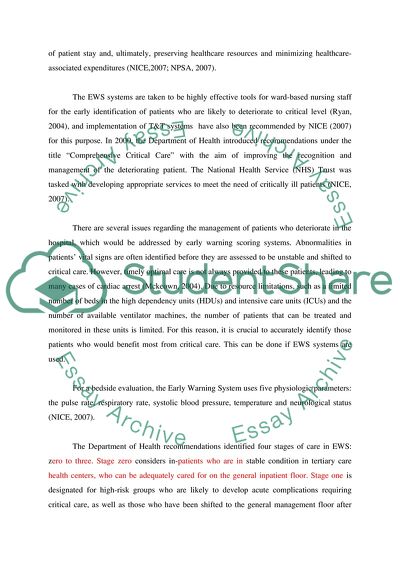Cite this document
(The Basic Principles of the EWS System Essay Example | Topics and Well Written Essays - 1750 words, n.d.)
The Basic Principles of the EWS System Essay Example | Topics and Well Written Essays - 1750 words. Retrieved from https://studentshare.org/nursing/1765560-explore-the-effectiveness-early-warning-scores-or-track-trigger-system-and-management-of-the-deteriorating-patient-define-and-explore-relevant-literature-and-policies-to-examine-the-extent-to-which-their-use-is-evidence-base
The Basic Principles of the EWS System Essay Example | Topics and Well Written Essays - 1750 words. Retrieved from https://studentshare.org/nursing/1765560-explore-the-effectiveness-early-warning-scores-or-track-trigger-system-and-management-of-the-deteriorating-patient-define-and-explore-relevant-literature-and-policies-to-examine-the-extent-to-which-their-use-is-evidence-base
(The Basic Principles of the EWS System Essay Example | Topics and Well Written Essays - 1750 Words)
The Basic Principles of the EWS System Essay Example | Topics and Well Written Essays - 1750 Words. https://studentshare.org/nursing/1765560-explore-the-effectiveness-early-warning-scores-or-track-trigger-system-and-management-of-the-deteriorating-patient-define-and-explore-relevant-literature-and-policies-to-examine-the-extent-to-which-their-use-is-evidence-base.
The Basic Principles of the EWS System Essay Example | Topics and Well Written Essays - 1750 Words. https://studentshare.org/nursing/1765560-explore-the-effectiveness-early-warning-scores-or-track-trigger-system-and-management-of-the-deteriorating-patient-define-and-explore-relevant-literature-and-policies-to-examine-the-extent-to-which-their-use-is-evidence-base.
“The Basic Principles of the EWS System Essay Example | Topics and Well Written Essays - 1750 Words”, n.d. https://studentshare.org/nursing/1765560-explore-the-effectiveness-early-warning-scores-or-track-trigger-system-and-management-of-the-deteriorating-patient-define-and-explore-relevant-literature-and-policies-to-examine-the-extent-to-which-their-use-is-evidence-base.


